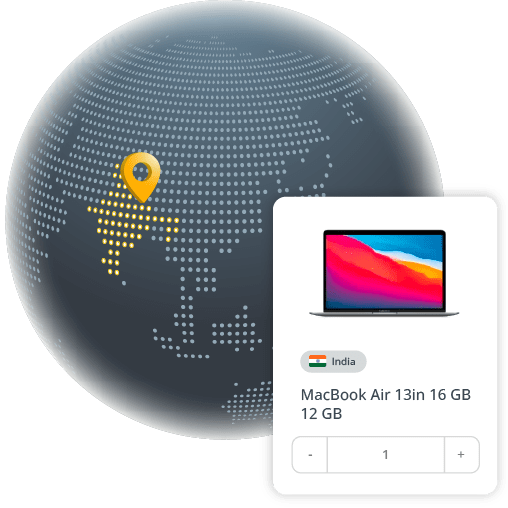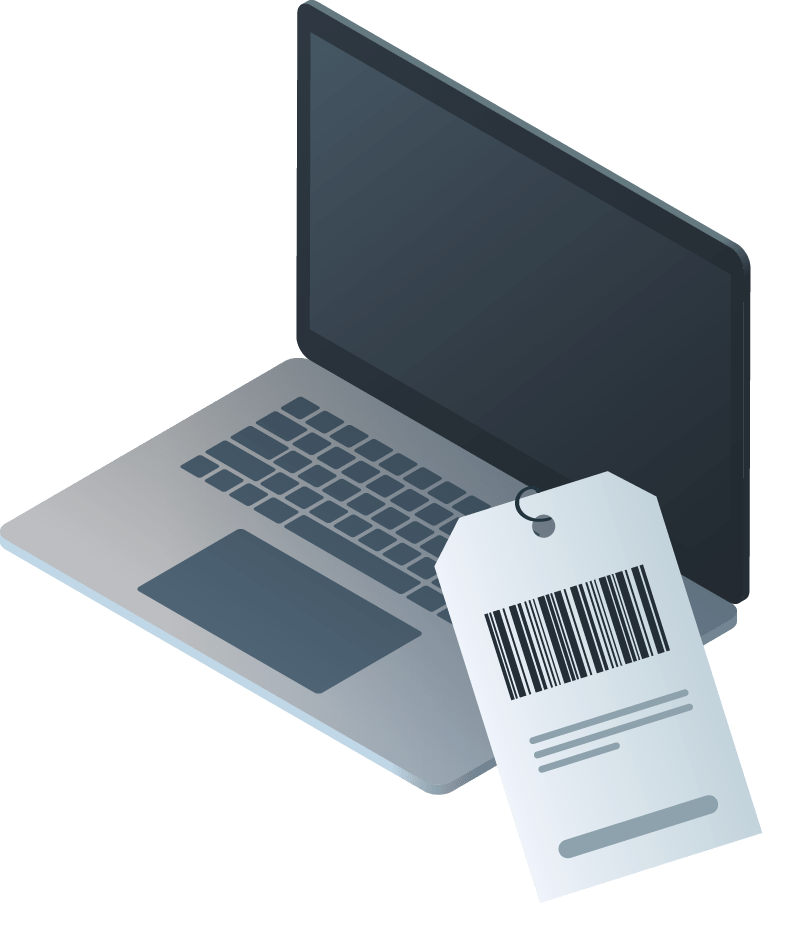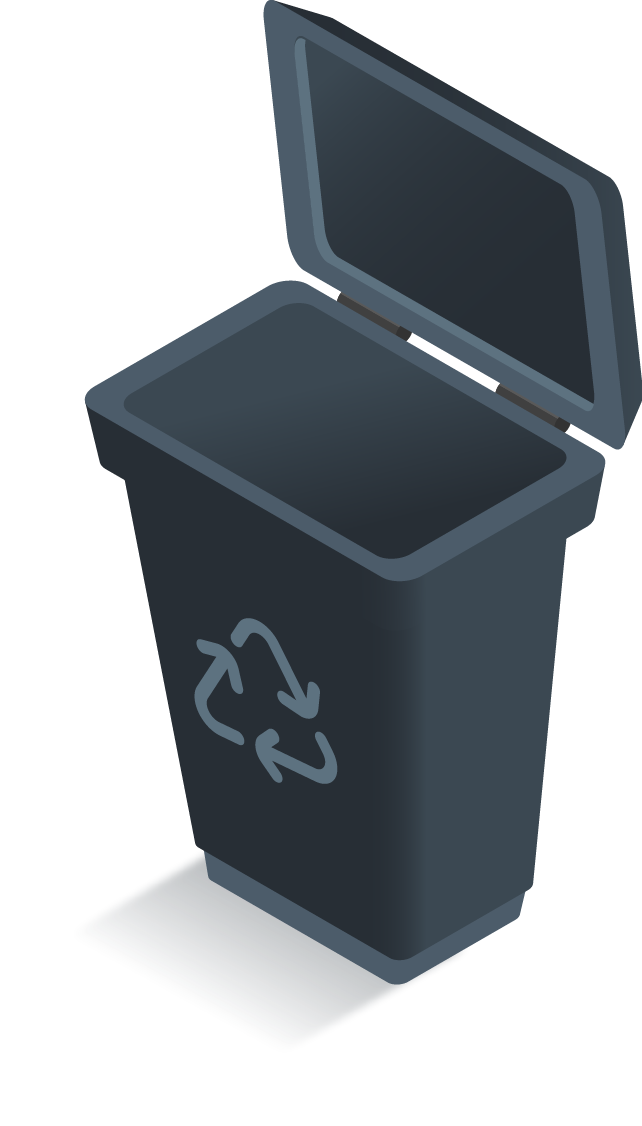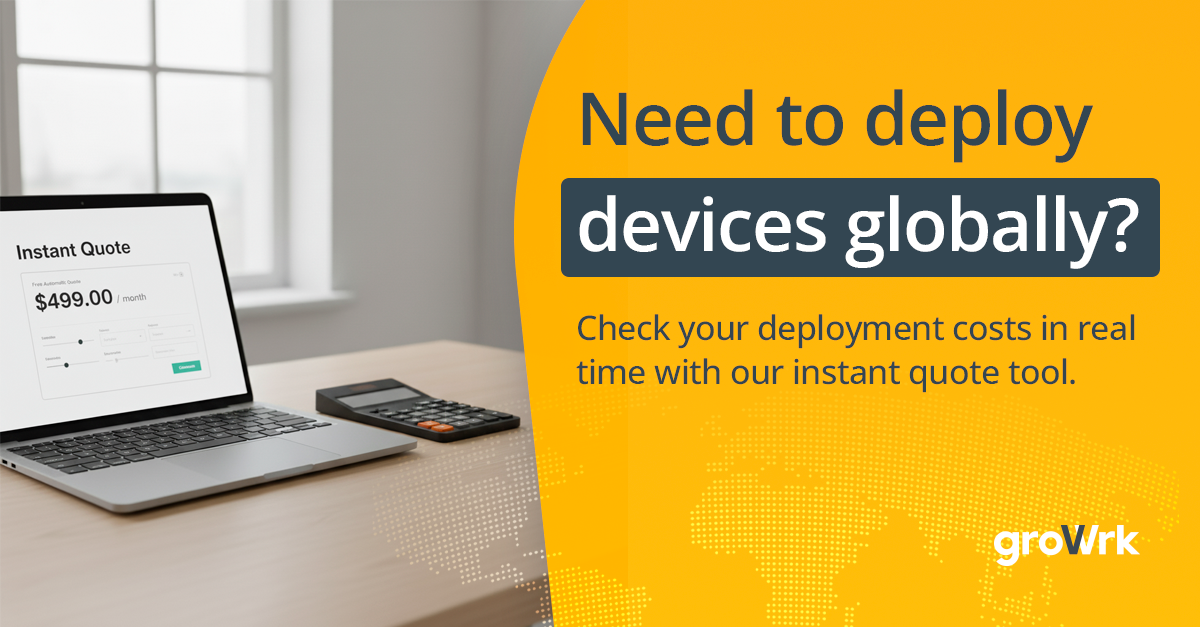How to send IT equipment to India
Need to ship IT equipment to your remote teams in India? GroWrk streamlines the process of managing technology across borders. Whether it's laptops, servers, or any other vital gear, we guarantee a secure and hassle-free delivery directly to India.

At a glance
India's IT sector is on a remarkable upward trajectory, with the digital economy set to experience exponential growth in the upcoming years. The nation’s expanding infrastructure and flourishing tech ecosystem are making it a key player in global digital transformation.
|
CURRENCY Indian Rupee (INR) |
OFFICIAL LANGUAGE Hindi, English |
TIME ZONE GMT +05:30 Indian Standard Time (IST) |
|
CUSTOMS DUTY ON ELECTRONICS 0-18% Typically 0-18% customs duties and 18% GST, with possible exemptions or reduced rates for select products. |
SHIPPING LEAD TIME 7-14 days (depending on shipping method and customs clearance) |
IT OUTSOURCING MARKET Expected to surpass $114.13 billion in 2025, fueled by the growing digital economy and a highly skilled workforce. |
Overview of IT operations in India

- Driving digital innovation: India is rapidly positioning itself as a leading hub for digital innovation. With a strong focus on improving internet access and expanding tech services, the country's emphasis on fintech, e-commerce, and digital solutions creates a dynamic environment for business growth and success.
- State-of-the-art IT infrastructure: Significant investments are being made in India’s IT infrastructure, from enhancing internet speeds and coverage to expanding the country’s network of data centers. These developments position India as a frontrunner in cloud computing and digital services, making it a top destination for businesses aiming to bolster their digital presence.
- Sustainability focus: India is deeply committed to a sustainable future. The government is spearheading initiatives encouraging green technologies while businesses across the country are aligning their strategies with eco-friendly practices. This makes India an attractive location for companies eager to innovate while keeping sustainability at the forefront.
- Highly skilled workforce: India has a vast pool of skilled talent in software development, cybersecurity, and systems management. With a strong focus on tech education and professional skill development, the country is becoming a go-to destination for companies looking for top-tier IT professionals to drive their innovation agendas.
- Business-friendly environment: India offers a stable and business-friendly environment, featuring enticing tax policies and robust data protection laws. The country's openness to foreign investment creates a fertile ground for international companies seeking expansion and success.
- Solid cybersecurity measures: India is strengthening its cybersecurity protocols with comprehensive legal frameworks to protect critical digital infrastructure, systems, and user data. These efforts ensure that businesses in India can operate within a secure environment, mitigating risks associated with the digital realm.
- A thriving tech hub: Cities like Bengaluru, Hyderabad, and Pune are emerging as thriving tech hubs, supported by a burgeoning startup ecosystem, government-led initiatives, and growing access to venture capital. With its rapidly evolving tech sector, India presents exciting opportunities for businesses seeking to innovate and scale.
Shipping IT equipment to India: What you need to know
| Customs regulations |
To ship IT equipment to India, it’s important to be aware of the country’s customs regulations. Complying with these rules ensures your shipment clears customs without unnecessary delays.
|
| Duties and taxes |
|
| Required documentation |
|
| Import restrictions |
|
| New vs. Used equipment |
|
| Penalties or fines for non-compliance |
|
Checklist for sending laptops to India
When shipping laptops to India, it’s important to follow a few best practices to ensure the process goes smoothly, and your equipment arrives safely and on time. Here are some helpful shipping tips:

Select trusted couriers: Choose reliable couriers such as GroWrk, DHL, UPS, FedEx, or India Post (Speed Post) for international shipping. These carriers offer tracking services and are experienced with Indian customs procedures.
Check service levels: Select the appropriate shipping option based on urgency. Express shipping (3-6 days) for high-priority deliveries. Standard shipping (7-14 days) for cost-effective options.
Use high-quality packaging: Secure laptops with sturdy, padded boxes and protective materials like bubble wrap, foam inserts, or air cushions to prevent damage during transit.
Disassemble where possible: If shipping accessories like chargers, docking stations, or monitors, package them separately to prevent damage. Remove detachable components if applicable.
Label clearly: Ensure the recipient’s name, address, and contact details are correctly labeled. Mark the package as "fragile" to encourage careful handling.
Accurate product descriptions: On the commercial invoice, provide a detailed and accurate description of the laptop, including its brand, model, and serial number. Inaccurate descriptions may cause customs delays.
Value declaration: Declare the correct value of the laptop to avoid under- or over-declaring, which could lead to customs inspections or fines. The declared value determines any applicable duties and taxes.
Customs declarations: All shipments to India must be declared at customs. Include: Bill of Entry (filed by the courier or customs broker), commercial invoice, packing list, KYC documents (PAN card, Aadhaar, passport, or company GSTIN for the recipient)
Proof of origin: If applicable, attach a certificate of origin to qualify for reduced duties under trade agreements, such as the ASEAN-India FTA or India-Korea CEPA.
Understand import duties & taxes: Laptops are classified under HS Code 8471, which are duty-free, but are subject to 18% IGST (Integrated Goods and Services Tax) based on CIF value (Cost + Insurance + Freight). Additional handling and customs clearance charges may apply, especially with courier handling agents.
Pre-pay duties and taxes: Some couriers allow for pre-paid duties and taxes to simplify customs clearance and prevent the recipient from facing unexpected charges upon arrival.
Protect against loss or damage: Consider purchasing shipping insurance for high-value laptops to protect against loss, theft, or damage during transit.
Compliance with Indian regulations: Ensure the laptop complies with BIS (Bureau of Indian Standards) certification and WPC (Wireless Planning & Coordination) licensing for wireless components if imported commercially or in bulk.
Use tracking tools: Major couriers provide real-time tracking—monitor shipments closely to anticipate customs clearance updates and delivery progress.
Stay in touch with the recipient: Notify the recipient about the expected delivery timeline, tracking updates, and any customs-related requirements to avoid delays.
Expect weather and seasonal delays: Shipments may be delayed due to monsoons, festivals (e.g., Diwali, Holi), or end-of-year demand spikes. Plan accordingly for critical deliveries.
Indian domestic delivery options: For final delivery, consider using India Post, Delhivery, Blue Dart, DTDC, or Ecom Express, which have extensive networks across urban and rural regions.

Average cost of IT Equipment in India
Laptops (Business Grade):
- Mid-range: $420 – $720 USD
- High-end: $720 – $1,200+ USD
High-end models such as Apple MacBook Pro, Dell XPS, and Lenovo ThinkPad are priced on the higher end.
Monitors (Business Grade):
- Standard: $100 – $180 USD
- Ultrawide/4K: $240 – $480+ USD
Monitors from trusted brands like Dell, Samsung, and LG typically range within these prices, with 4K or ultrawide models costing more.
Desktops (Business Grade):
- Standard Desktop PC: $480 – $720 USD
- Workstation Desktop (for high-performance tasks): $720 – $1,200+ USD
Prices depend on the brand and specifications, with options from HP, Lenovo, and Apple among the most common.
Printers (Laser):
- Standard Office Printers: $100 – $180 USD
- High-Volume Printers: $240 – $600+ USD
Leading brands such as HP, Canon, and Brother offer a wide range of models for office environments.
Public holidays & IT work hours to plan your shipment
Key public holidays in India:
- New Year’s Day – January 1
- Republic Day – January 26
- Good Friday – Date varies (usually in April)
- Labour Day – May 1
- Independence Day – August 15
- Gandhi Jayanti – October 2
- Dussehra – Date varies (usually September or October)
- Diwali – Date varies (usually October or November)
- Christmas Day – December 25
Typical work hours for IT professionals
- IT professionals in India typically follow a 40-hour workweek, distributed from Monday to Friday. Standard office hours are usually from 9:00 AM to 6:00 PM, though many IT firms are now offering more flexibility. Employees can often customize their working hours as long as they fulfill the required number of hours, which supports a better work-life balance.
- Overtime regulations in India are governed by labor laws, ensuring that employees are compensated for extra work. Any work beyond the regular hours is generally paid at 1.5 times the normal hourly rate. If employees work during weekends or public holidays, the overtime pay rate may increase, depending on the company’s policy and the nature of the work.
What to consider when retrieving IT equipment from employees in India
| Local delivery and logistics services |
|
| Inventory management |
|
| Logistics challenges for remote locations |
|
| Equipment agreement with employees |
|
How to dispose of IT equipment in India
E-Waste Recycling:
- WEEE Compliance: Always choose certified e-waste recycling partners compliant with India’s Electronic Waste (Management) Rules. These certified providers will manage your equipment's recycling according to legal and environmental standards and provide documentation confirming that the disposal process meets regulatory and eco-friendly guidelines.
- Certified E-Waste disposal: To meet India’s environmental requirements, engage certified e-waste disposal services. These professionals specialize in dismantling IT equipment, properly handling hazardous materials like batteries and circuit boards, and ensuring that the devices are recycled in an eco-friendly manner.
- Recycling centers: Local recycling centers across India can efficiently handle the disposal process for smaller devices. However, specialized disposal services are required for larger or more complex equipment like servers or data storage systems. These services comply with legal and environmental standards to ensure proper equipment processing.
Data Destruction:
- Data wiping: Before discarding any IT devices, it’s crucial to thoroughly wipe all data from devices such as hard drives, SSDs, and mobile phones. Employ certified data-wiping software to permanently erase all sensitive information, leaving no chance for recovery. This step is vital in preventing data breaches and safeguarding confidential data.
Physical destruction: Physical destruction of storage media is a reliable option for those who need absolute certainty that data is irretrievable. Techniques like shredding, crushing, or degaussing can destroy the device, ensuring no one can access the data. This method is highly recommended in cases where security is a top priority.
Repurposing or Donating:
- Donating to charitable organizations: If your IT equipment is still functional, consider donating it to schools, nonprofit organizations, or community groups in India. Donating working devices reduces electronic waste and supports educational and charitable initiatives, benefiting those in need.
- Internal repurposing: Repurposing older equipment internally can be an effective strategy for businesses that regularly upgrade their IT systems. Older devices can be used for less demanding tasks or allocated to departments that don’t require the latest technology, thus extending their useful life and minimizing waste.
Manufacturer Recycling Programs
- Many IT equipment manufacturers in India offer take-back programs, allowing businesses to return their outdated devices for proper recycling or repurposing. These initiatives help ensure that old equipment is disposed of responsibly and under environmental laws.
.

Local IT Outsourcing Solutions in India
You can streamline your IT logistics and asset management with GroWrk’s comprehensive global solution. Whether it’s shipping equipment or managing IT assets across multiple regions, GroWrk helps you stay compliant and efficient, every step of the way. Here’s why GroWrk is the ideal partner for managing your IT assets in India:

| 1. Wide global coverage |
We bring global IT outsourcing experience combined with a thorough understanding of the Indian market. Our approach ensures your operations comply with local regulations and industry best practices, addressing both technical and legal requirements for seamless business operations. |
| 2. End-to-end asset management |
We oversee the full IT asset lifecycle—from procurement to disposal. With our integrated logistics and infrastructure support, you can focus on your core business while we take care of all the details of managing your IT equipment throughout its life. |
| 3. Intuitive platform for easy deployment |
Our platform makes it easy to track and manage IT assets across India. By centralizing asset management, we relieve you of logistical burdens, helping your team stay organized, productive, and efficient across all locations. |
| 4. Smooth delivery and equipment retrieval |
We ensure the smooth and timely delivery of IT devices, including laptops, to employees all over India. We also handle the return of equipment when employees leave, streamlining the process and keeping costs under control for your business. |
| 5. Compliance with Indian import regulations |
We ensure that your shipments comply with India's import regulations, customs procedures, and tax requirements. From handling Goods and Services Tax (GST) to managing duties and other local compliance concerns, we make sure your IT equipment arrives on time, without delay. |
| 6. Efficient repairs and maintenance |
We offer quick and reliable repair and maintenance services to keep your IT equipment in peak condition. By addressing issues promptly, we minimize downtime and ensure your teams across India stay productive without interruptions. |
| 7. 24/7 Support for peace of mind |
Our customer support team is available around the clock to assist with any inquiries regarding asset management, logistics, or shipping. Whether it's during business hours or after, we’re always here to help ensure that your IT operations in India run smoothly, 24/7. |
Procure, configure, and deploy your IT devices from one platform


